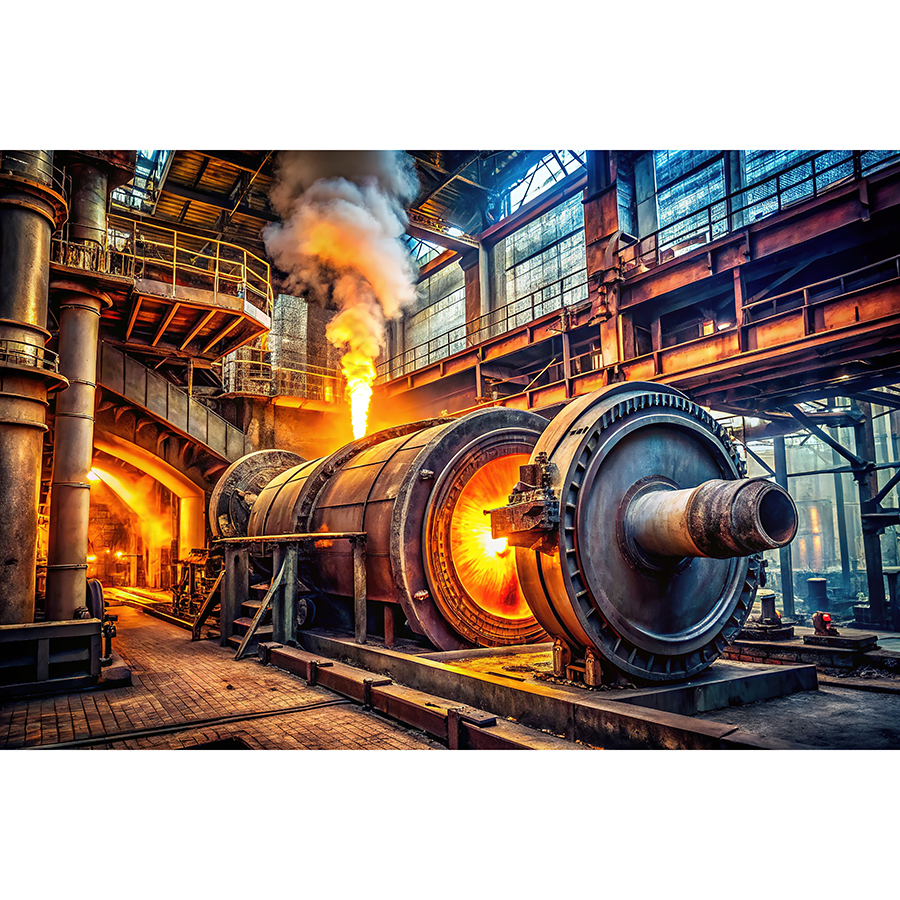
Calcination
Calcination is a thermal process. It involves treating a solid at high temperatures. These are typically between 400 °C and 1000 °C, but always below the melting point of the material. The aim is to bring about chemical or physical changes in the material. The process usually takes place under atmospheric conditions. It is usually carried out continuously. Air or oxygen is often present, as many reactions require this. However, it is not absolutely necessary. In some cases, calcination takes place in an inert gas atmosphere to prevent oxidation.
Calcination is a generic term for various thermal processes. These include, for example, deacidification, reduction, oxidation or the dehydration of crystalline water components. Related processes are pyrolysis and the thermal decomposition of organic components. Sintering, roasting and incineration are also related processes. Calcination is usually endothermic. Reaction products such as carbon dioxide, water or ammonia are released.
Different types of furnaces are used depending on the requirements. In rotary kilns, the residence time is typically 0.5 to 3 hours. Tunnel kilns operate with times of 2 to 12 hours. In shaft kilns, residence times of 4 to 30 hours can occur. Fluidised bed furnaces enable particularly short residence times of 0.5 to 10 minutes.
The raw materials are usually crushed and homogenised before calcination. The aim is to achieve a uniform particle size distribution. The finer the particles, the larger their reaction surface. This also improves heat transfer in the reactor. A homogeneous composition of the raw material mixture is a prerequisite for a complete reaction. Gyraton® silo mixers can homogenise large batches with ideal precision. Calcination is often followed by embrittlement and agglomeration. For this reason, comminution is often carried out afterwards.
Alternative processes are used in some cases to save energy and resources. These include wet chemical or biological methods. These differ in terms of process duration, selectivity and environmental compatibility. Thermal calcination offers a high reaction speed and a sterilising effect, but does not require water. On the other hand, energy consumption is high. Wet chemical processes, on the other hand, are finely controllable and selective. They usually require environmentally critical media such as acids or alkalis. The residues must be clarified. Biological processes such as bioleaching are energy-efficient and environmentally friendly. However, they are time-consuming and can only be used for a few material systems. In special cases, the Gyraton®mixing silo can be used as a fermenter.
amixon® equipment can improve the efficiency of calcination processes. Dusty powders can be continuously agglomerated in the ring layer mixing agglomerator. The porosity of the solids is retained. This reduces material losses.
In Gyraton®mixing silos, large quantities of raw materials can be homogenised. A uniform composition facilitates process control.
With intensive mixers from amixon®, even the finest additives can be precisely distributed in powder mixtures. Even very small quantities can be reliably incorporated. This improves the calcination and sintering processes.
After wet chemical treatment, the contact dryers from amixon® shorten the drying time. This is possible both in batches and continuously. In many cases, drying under vacuum is advisable. This is particularly true for temperature-sensitive salts in which enzymes or microorganisms are to be preserved.
Explanation
Chemists sometimes refer to the drying of salt-containing compounds as calcination. Such drying processes usually take longer and require higher temperatures. This releases crystal water and breaks down crystalline bonds. Examples include aluminium sulphate, copper sulphate, iron(II) sulphate, zinc sulphate, sodium acetate trihydrate, magnesium chloride hexahydrate, sodium carbonate decahydrate, ammonium molybdate and lithium hydroxide.
There are also drying processes for saline substrates from biochemistry. In these processes, fermentation residues are dried under vacuum conditions to isolate microorganisms or enzymes. In such cases, however, calcination in the strict sense does not occur, as no chemical transformation takes place, but only water is removed.
